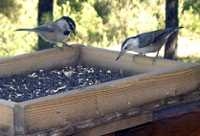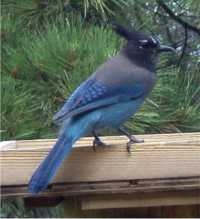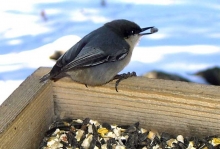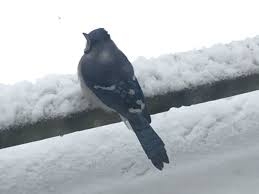Winter Bird Notes
By Joyce Wolff
Photos by Walt Wolff
January 2001 is here and finds the Ranch covered with snow. And typical of this area it can be icy cold one day with record warm temperatures the next. Winter is a time when bird feeding is especially rewarding both for the birds and us.
There are several species of winter resident birds that hungrily appear every day at our feeders.
All the bird sounds that you hear in the fall and winter are “call notes.” Birds only “sing” pretty songs in spring and summer, the breeding season. The Townsend’s Solitaire is the exception here, but that’s another story.
| All the bird sounds that you hear in the fall and winter are “call notes.” Birds only “sing” pretty songs in spring and summer, the breeding season. The Townsend’s Solitaire is the exception here, but that’s another story. |
The most common and numerous this winter are Pygmy Nuthatches. Throughout the year they are heard twittering and seen flitting at the tips of the ponderosa boughs, but this year they are flocking to the feeder. They, along with their relatives the chickadees, are brazen birdlets that will eat from your hand quite readily if you are patient. Mountain Chickadees, the only chickadees with a white strip over their eyes, can be heard calling yearlong. Bird guides and birding friends tell me that Black-capped Chickadees (no strips on their heads) could be here and certainly are found in mountainous Colorado, but so far we have only seen Mountain Chickadees on Loma Lobo (Wolf Hill).
Another small black and white bird, larger than the Pygmy Nuthatch, is the White-breasted Nuthatch, who quickly nicks a seed then flies to a quiet spot to crack it open in peace - apparently a most discerning diner. They are the upside down birds who travel the undersides of limbs, then up one side and down the other on the trunks. You will see only one or two at a time. A pair is territorial (25–50 acres) and will not allow another White-breasted Nuthatch within its space. I have seen more than two at a time, but only in the spring or summer when wandering individuals are looking for a nesting area (or as family groups are feeding together before the juveniles leave home). During these bird wars they let you know that there is trouble a-wing with threatening chirps and "yank, yank, yanks," as the resident birds defend their territory against the usurpers. Last spring a second nuthatch soon appeared after one of a pair dove into a window and died.
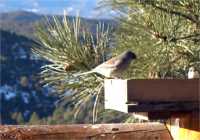
|
The last of the small winter birds who appreciate food offerings are ground feeding juncos, who prefer seeds that the other birds spill on the ground (or deck). They will eat from trays but it is not their preference. Juncos wear several costumes. They are gray with rusty backs (Gray-headed Juncos) and all shades of gray, cream and buff with dark heads (Oregon Juncos) but they are all Dark-eyed Juncos. (This in case you look them up and are confused by a field guide.) |
The territories for Scrub Jays and Steller's Jays, both common at feeders, overlap in this habitat, the Transition zone. Scrub Jays like the pinon/juniper (pj), while the darker blue Steller’s Jays, with their jaunty black crests, prefer the ponderosas. We see them in equal numbers. A Scrub Jay is not a female Steller’s Jay though it’s a reasonable assumption before checking a field guide. Male and female look alike in both these species.
Other birds may be about this time of year. Magpies wander in from Trinidad every now and then; beautiful Rufous-sided Towhees and Titmice (not mouses) occasionally appear at the seed tray, and woodpeckers, flickers, solitaires and robins come to water both to drink and take icy but enthusiastic baths.
Although not at winter feeders you might also see Mountain Bluebirds, Eastern Bluebirds and Western Bluebirds sitting on power lines looking gray not blue.Their populations were declining several decades ago until a mounted effort was begun in the east to provide them with appropriate nest boxes. Thus began “bluebird trails.” The idea caught on and most states now have bluebird trail programs, Colorado included, through the Division of Wildlife (CDOW). Monitors complete field forms to provide accurate data on nest box success. Nest boxes are built to specs required for the species you want to attract. If you want to provide a home for a bluebird family, or any other species for that matter, now is the time to put the box out so that it will weather a bit by spring. Many birds start scouting real estate long before they are ready to inhabit.
| Before venturing on to bluebirds, a note on bird notation. A species name is capitalized to differentiate the species name from a descriptive name. A blue bird is not a species - it is a bird that is blue. A Blue Jay is capitalized because it is a species but it is also a blue jay and a blue bird. Incidentally, Blue Jays are eastern birds rarely seen in these foothills. The word bluebird refers to the several species (a family) including the three species listed in the next paragraph. Good Grief! |
The bluebird house will attract several species. The recent Colorado Bluebird Project Update from the CDOW gives this tally for fledged birds from bluebird boxes last year where they were monitored: 227 Mountain Bluebirds, 30 Western Bluebirds, 6 Eastern Bluebirds, 53 Ash-throated Flycatchers and 8 House Finches. The nest boxes we have put up around Loma Lobo are used every year. (Chickadees love them.) We have added several more this fall. And remember that putting up a flicker nest box might prevent a flicker from turning your siding into kindling.
Watching birds vying for occupancy is great fun. Last spring we watched a jangled bluebird teeter out from a nest box after a flicker landed on the backside and began drumming. Whoa, now that’s an Excedrin headache!


